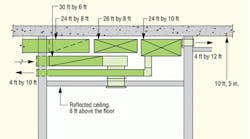Expanding a health-care provider's services invariably requires the modification of an existing structure or the construction of a new one. Because engineers tend to minimize their involvement during the programming, conceptual, and schematic phases of facility projects, space plans often are developed and approved without engineering input, and given constraints typically are accepted. This article discusses a more integrated approach to space planning through a stronger and more dynamic collaboration between architects and engineers.
MISSION ANALYSIS
For a facility owner to determine whether a new or a renovated building is more suitable and which new systems need to be installed, a project's architect and engineers must analyze and understand the owner's requirements as well as design conceptual plans.
First, an extensive survey and code analysis of the existing structure being considered for renovation must be completed to identify any required upgrades. Schedules and estimated expenses, such as life-cycle costs, then can be developed for various renovation scenarios.
At the same time, the architect and engineers should analyze new-facility requirements to create a building plan that will optimize the owner's needs. There may be more than one solution for some of the required systems, particularly the mechanical and electrical ones, all of which should be included in the review. To eliminate system or building-type bias, a new-facility analysis should not refer to the possibility of building reutilization.
The analyses should maximize the owner's ability to provide medical care efficiently at the lowest possible cost while creating a sustainable building that maximizes the energy efficiency of all of the integrated systems. Conceptual plans that incorporate spatial needs as well as mechanical and electrical systems should be used to evaluate the adaptability of an existing building. The plans also should be used to create a new-building outline that complies with the owner's needs in all respects.
ADVANTAGES AND DISADVANTAGES OF EXISTING-BUILDING RENOVATION
There are several advantages to renovating an existing building, including:
-
Occupancy can occur more quickly than it can with new construction.
-
Site acquisition and related costs are eliminated.
-
Long-term-site-use, wetlands, and environmental approvals are unnecessary.
-
Reutilization of various building components can decrease costs.
-
Demolition volume and its impact on neighbors is reduced.
There are, of course, several disadvantages as well, including:
-
The aesthetics of the completed building's interior will be the result of compromises made in the modification process and may distract from the goal of quality medical care.
-
There may be costs associated with health- and safety-code compliance; structural issues, such as reinforcing floors; upgrading existing walls/windows; and integrating existing mechanical, electrical, and plumbing (MEP) systems into new systems, including expenses associated with inadequate headroom, which can increase MEP-system installation costs.
-
Low-hung ceilings can limit lighting-fixture selection and contribute to a poor building image.
Page 2 of 3
SURVEYING AN EXISTING BUILDING
As previously mentioned, existing buildings first must be surveyed by the architect and engineers. Current code requirements may be more stringent than those used when the building was constructed, and upgrades may be required to meet new codes. If existing floor plans are available, they should be checked thoroughly against actual conditions for accuracy of dimensions, floor-to-floor heights, materials used in building construction, distances to exits, stair locations, column spacing, shaft and chase locations, etc.
Walls and ceilings should be opened to check the accuracy of the existing plans and to confirm the sizes of the various columns and beams. The structural engineer should identify the locations, sizes, and weights of columns and beams, as well as the floor thickness and construction methods. From those, the allowable loads for each floor — and the possibility of reinforcement — can be determined. The ability to remove columns and modify the structure accordingly also can be established.
The mechanical engineer should identify the type, size, capacity, and distribution systems of the building's air-handling fans and heating, cooling, ventilation, and duct-distribution systems. The age, condition, maintenance level, and probable remaining useful life of these systems must be assessed to determine their ability to continue serving the building. Medical-gas systems, such as compressed air, vacuum air, and oxygen, must be surveyed as well.
The mechanical engineer also should survey the sprinkler, domestic hot- and cold-water, and sanitary and storm-water systems. Piping systems can be the most difficult to assess, as they usually are concealed in walls, chases, and shafts. It is impractical to open all of these areas to get a complete picture of their condition. For critical systems, it is wise to remove a sample of the piping and have it analyzed in a laboratory. Piping and ductwork sizes and routing paths should be determined before a decision whether to reuse or replace them is made.
The electrical engineer should survey the size and condition of the building's incoming electric service. The condition and loading of the building's distribution system, including switchgear, distribution and branch panels, and feeders, should be inspected and documented. It may be necessary to test the feeders if their condition is questionable. Sizes and locations of site services, such as sprinkler, standpipe, electric, water, telephone, fiber optic, sanitary, storm, gas, and oil, should be determined.
Additionally, the architect should assess the value of replacing older windows and upgrading perimeter-wall and roof insulation.
It is even more critical to generate a detailed survey of the existing building and its systems if the facility requires floors to be renovated individually. This scenario usually requires existing systems to remain in operation during each floor's renovation, which severely limits the design team's options.
Finally, it is important for survey teams to note that the information they gather will impact the final decision directly. Collected data will be used to generate cost estimates for the proposed work; the more accurate the estimates, the easier the decision-making process will be.
ADAPTING A BUILDING FOR REUSE
Using all of the data collected during the facility survey, conceptual drawings should be superimposed on the existing building's plan. The building then should be modified, as far as is practical, to accommodate the proposed use. With the exception of buildings that contain only patient floors, each floor of a medical building is assigned a unique purpose and has unique requirements. Radiology floors house heavy equipment; laboratories contain major piping and power runs.
Modifications may include column and exit-stair relocation, roof and floor-system reinforcement, new windows and doors, and story additions. Floors with the heaviest loads, such as radiology floors, should be located on the lowest levels to minimize structural-revision costs.
When practical and efficient, mechanical and electrical systems should incorporate existing elements where they can be integrated with the space layout. Vertical shafts should be located throughout the building at strategic intervals along a corridor wall, preferably one that is not beneath a beam. These shafts should convey all of the piping and conduit risers through the building with capped connections at each floor level for future use. Access doors from the corridors into the shafts allow riser maintenance and repair to occur without workspace disruption, thereby reducing the risk of disease spread and minimizing the inconvenience to patients and staff.
Typically, the cooling/heating needs of diverse-use floors should be handled by dedicated air-handling units and appropriate supply and return ductwork confined to the floor being served. This design eliminates the need for large duct shafts to run vertically through the building from the roof or basement mechanical rooms. Exhaust ducts should run only in vertical shafts. Each floor should have a dedicated mechanical room — located on an outside wall — that contains all of the equipment needed for cooling, heating, and ventilating the floor on which it is located. Space should be built in to allow for easy system replacement and maintenance with minimum impact on building occupants.
Page 3 of 3
IT INFRASTRUCTURE
The computerization of medical care is forcing a re-evaluation of the overall importance of information-technology (IT) infrastructures in medical facilities. In many facilities, there are no central-server systems integrating patient, radiological, laboratory, outpatient, emergency-room, maintenance, and operational records. Most of these are stand-alone systems requiring diverse protocols that cannot be incorporated into a single control unit.
Computerized controls for most systems often are installed by multiple vendors and cannot interact. Control modules/boards require continuous 24/7 cooling with backup to prevent overheating and burnout. Their shelf life is short — approximately three years — and they are expensive to replace if they burn out prematurely. Revenue losses occur if the equipment being controlled is inoperable because of board failure.
During the IT-space-planning process, the design must include adequate space for the equipment that will provide overall cooling. Then, the needs of individual pieces of IT equipment within the space must be met. IT equipment will have different cooling parameters than the overall space in which it resides. The space also must allow for inevitable future increases in computer servers and controllers.
INFECTION CONTROL
Controlling hospital infection rates during demolition and construction phases must be a key element of the design process. Interacting with the facility's infection-control group will be necessary to understand the extent of infection control needed. The architect/engineer design team must maintain and monitor acceptable indoor-air quality on a continuous basis during the construction phase.
The American Institute of Architects, the Centers for Disease Control, and the Joint Commission on the Accreditation of Healthcare Organizations (JCAHO) have issued guidelines on this topic for patient areas. JCAHO has made the guidelines, which can be found in JCAHO Environment of Care Standard 1.7, Utility Systems Management, mandatory for their accreditation process. When carefully considered and implemented, the guidelines protect construction workers, hospital staff members, and patients.
ENVIRONMENTAL CONSIDERATIONS
The architect and engineers should base their design approach on system sustainability and incorporate energy-conservation measures that are appropriate in terms of cost and carbon-footprint reduction. The design also should be measured against the Leadership in Energy and Environmental Design (LEED) Green Building Rating System to determine if a LEED rating can be earned.
CODE ANALYSIS
The proposed solution — be it renovation or new construction — should be examined for compliance with applicable codes and regulations. The analysis should include the fire rating of the building and its materials; emergency egress; fire stairs and their allowable distances; seismic bracing; floor-loading capacity; emergency power, lighting, and distribution; fire-standpipe and sprinkler systems; fire-alarm and notification systems with accompanying shutdowns; smoke-evacuation systems; stair and building pressurization; ventilation requirements; infectious-disease control; air filtration and distribution; patient evacuation; and structural compliance.
When the project has been completed, a certificate of occupancy will be requested from the project's assigned jurisdiction official. The official will need proof of compliance with these requirements prior to signing off on a certificate of occupancy.
FINAL ANALYSES
The architect and engineers should prepare estimates of cost and construction duration for existing-building renovation and new-building construction. The estimates should be based on the owner's requirements at the conceptual-design level. A life-cycle-cost analysis, including energy usage, also should be prepared for both scenarios. Finally, both options should be analyzed for staffing efficiency and movement, patient care and movement, maintenance, operation, and facility housekeeping, as well as the cost implications of each.
CONCLUSION
The final decision to renovate or build inevitably will be the result of a series of compromises caused by the conflicting needs of the different constituents who will occupy the building. The key is to fully understand the compromises made and their impacts on the building's long-term use. The owner then can make a reasonable decision based on construction cost, time to market, and life-cycle operating and functionality costs.
The senior mechanical engineer for DLB Associates Consulting Engineers, William J. Dunne, PE, received a bachelor's degree in engineering from University College Dublin and a master's degree in business administration from New York University. He has extensive experience in health-care, education, industrial, and commercial projects. Joshua Burdick, AIA, LEED AP, is the president of SBLM Architects. He has a bachelor's degree from the University of Bridgeport and is a member of the Royal Institute of British Architects, the Royal Architectural Institute of Canada, the Construction Specifications Institute, the National Trust for Historic Preservation, and Building Officials and Code Administrators International.










